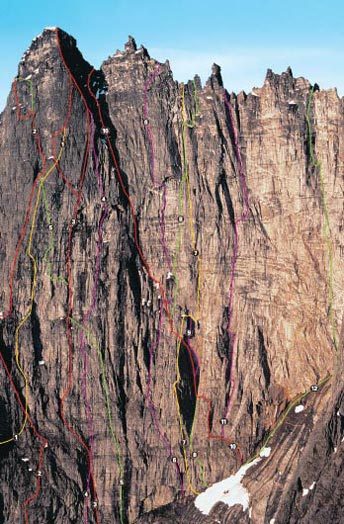
Norway’s Trollveggen (Troll Wall), showing: 1. Baltica (VI 5.11- A3+, 1300m, Odintsov-Potanikin, 1997). 2. Norwegian Route (VI 5.9, 1300m, Patterson-Teigland-Enerson-Eliassen, 1965). 3. French Route (VI 5.9 A4, 1200m, Deck-Boussard-Cordier-Brunet-Frehel, 1967). 4. Russian Route (VI 5.10 A4, 1100m, Kolshelenko-Ruchkin, 1997). 5. Arch Wall (VI 5.10 A4+, 1200m, Drummond-Drummond, 1972). 6. Trolldom (VI 5.11 A3, 1050m, Vadla-Magnussen, 1985). 7. El Cami dels Somnis (VI 5.9 A3, 100m, Castellvi-Grau-Porta, 1986). 8. Swedish Route (VI 5.11, 1000m, Johansson-Nilsson, 1978). 9. Raspberry Dream (VI 5.12, 950m, Aastorp-Vadla, 1987). 10. Rimmon Route (VI 5.10, 900m, Amatt-Howard-Tweedale, 1965). 11. Trollkjerring Route (VI 5.11, 900m, Doseth and partner, 1982). 12. Death to Everyone (VI A4, 600m, Vadla and partners, 1986). [Photo] Aslak Aastorp
Trollveggen, Rimmon Route and Norwegian Route, Winter Repetitions. Benoit Chanal, Aymeric Clouet, Arnaud Drouet, Christophe Dumarest, Francois Dupety, Didier Jourdain, Pierrick Keller, Marchal Messemeci and Jean Francois Reffet were all between twenty-one and twenty-five years old, in training for the Guide Candidate course and possessed of the same motivation: to climb in the world’s great mountain ranges.
“Hi, guys.”
“Howdy, leaders. Where are we headed for the aid-climbing session? To the Verdon Castapiane?”
“No, we have selected a dreamy little place, with a little snow, for climbing in the shade. Instead of heading south, we’re going north, to Norway and the north face of Trollveggen. We will hope for mild conditions; however, we know that the last winter ascent, by two Russian teams in 1997, was done without a single day of decent weather…”
That was the start of the ENJA (Aquipe National Jeune Alpinisme) aid-climbing session. We arrived in Oslo via ferry at 9 a.m. on February 21. As the boat broke through the ice we had second thoughts about our objectives. Six hours in a car saw us in Romsdal at the foot of the Trollveggen, an austere wall, 1500 meters at its highest point; we were greeted by temperatures of -15 degrees celsius and a wind of forty kilometers per hour.
Once the gear was deposited at the foot of the face, two teams went to work locating the two 1997 Russian routes, the Russian Route (VI 5.10 A4, 1100m, Koshelenko-Ruchkin) and Baltica (VI 5.11- A3+, 1300m, Odintsov-Potanikin), which turned out to be a little difficult for an aid-climbing school under such conditions. The temperature in the valley hadn’t changed, and a violent wind from the south pushed against the disturbances from the north for the two weeks of our stay. With only eight days left, we decided to change objectives and tackle some more feasible projects: The Norwegian Route (VI 5.9, 1300m, Patterson-Teigland-Enerson-Eliassen, 1965) and the Rimmon Route (VI 5.10, 900m, Amatt-Howard-Tweedale, 1965).
After fixing 500 meters of static line on the Norwegian Route, Arnaud, Aymeric and Jean Francois got the ball rolling. They ascended the fixed lines and spent the night on a ledge 500 meters below the summit. The next day was Marchal, Benoit and Pierrick’s turn to ascend the endless fixed lines. The next day, much to the surprise of the students, the coaches (two old druids and I) started up the Norwegian Route to remove the 500 meters of fixed line. In all, we made three winter ascents of the route, all taking four days–the fastest winter ascents to date. (See p. 88 for a photo and route lines of Trollveggen –Ed.)
On the same day Didier, Christophe and Franois tackled the supposedly-easy Rimmon Route. They realized at the end of two days’ climbing that this route was part of the September 1998 rockfall; five pitches had disappeared. The route had not been ascended since, and they would tell us later that they had to sleep in their haulbags to protect themselves from recurring rockfall. Seven new pitches (5.9 A2) were added in the rock-scar section, and four days were required to complete the route.
— Gael Bouquet des Chaux, Chambery, France (translated by Eric Bye)